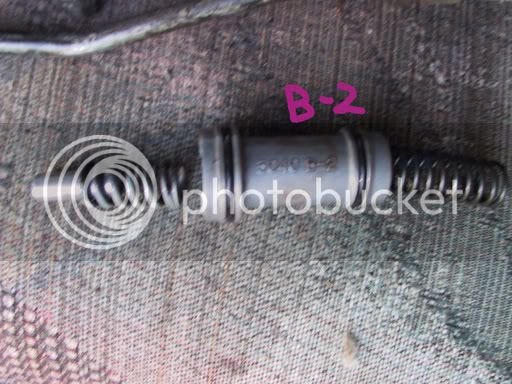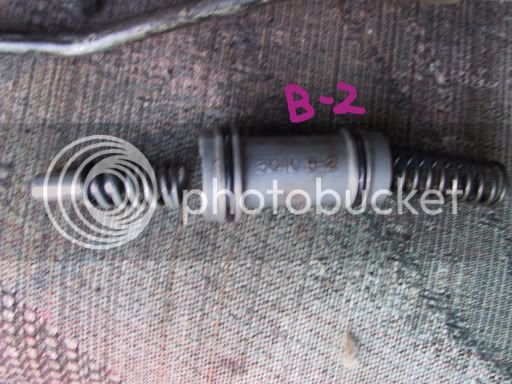Brad Bedell
New Member
- Messages
- 88
- Location
- Dallas TX
Not sure if anyone else has gotten into these things, I posted this in the IS300 forums, but I know you guys are considerably more curious than the bulk of those guys. I figure I'll open the floor for a discussion to help me get my head around the whole valve body operation.
First things first, the 'shift kits' I've seen out there are pretty simple in design. They use a rod to limit the movement of the Accumulator piston. The only reason an accumulator is used is to absorb the shock of the hydraulic pressure between shifts.
It seems the easiest solution is to use a rod to stop that movement. My concern is that the rods stopping a moving item will eventually wear parts that probably were not designed to be worn. A stainless rod would wear the valve body and accumulator piston. An aluminum rod would eventually wear aluminum to aluminum. Toyota switched from Steel balls in the valve bodies to plastic ones for this reason.
Other ways to accomplish similar results with faster/stiffer shifting would be increasing pressure, raising volume to the accumulators or stiffer springs. Various Toyota models tweak these adjustments as seen below:
Accumulator pistons with limiting rods are shown here: (note the C0 Accumulator has a rod in this shift kit, it's the only one I've seen with it. )

From left to right:
B2: 3rd brake
c2: Direct Clutch
B0: Overdrive brake (which seems to be omitted in some shift kits)
C0: Overdrive Direct Clutch
This is how the GS400 accumulators come stock:

What's interesting is The IS300 C0 accumulator did not have the secondary spring inside as seen here:

My LS430 C2 spring had a helper spring and keeper, it looked like this:

The A340 box has rods in the lower springs also, Makes me think they were trying to close off some of the accumulator volume by limiting that spring:

Toyota also has built in adjustments on the following items:
primary regulator valve: 3 position that tightens the springs about 1mm per click. Shown in pic in the tightest position:

The accumulator control valve:

Release control valve:

The line pressure control solenoid has adjustments on it, as well as the lockup control solenoid. I'll photo these as I get time.
This chart shows what's being used in the gear of choice:

Key:
B0: Overdrive brake (which seems to be omitted in some shift kits)
B1: 3rd Coast Brake
B2: 3rd brake
B3: 2nd Brake
B4: 1st & Reverse Brake
C0: Overdrive Direct Clutch
c1: Forward Clutch
c2: Direct Clutch
F0: Overdrive 1 way Clutch
F1: No. 1 One Way Clutch
F2: No. 2 One Way Clutch
So, regarding accumulators, I'm interpreting that since B0 isn't used for anything in the chart, other than reverse and 5th gear, it's probably not necessary to stick a rod in. Can anyone speak of other shift kits?
I'm still wrapping my head around the whole thing, but I suspect there's quite a bit of tweaking available without even messing with the accumulators.
Anyone have any corrections as to the info I've shown or input from experience? Ideally, I'd like to not share in public the rod lengths from various kit builders. It's just bad form and they help us out from time to time. I do have the T274 TIS Toyota Training manual in PDF form. It goes over the A750 box, but Auto Transmissions are all similar in design. I'd like to find one of the earlier courses that covers the A650.
Reference threads that I've found, regarding the A340 transmission that have good info are here:
Tranny tech said "don't do VB upgrade" - CustomTacos.com Forum
MK3 TSRM On-Line
How to make a a340 last(56kers take a nap) - Supraforums.com
Modding the A340LE transmission - PerformanceForums
First things first, the 'shift kits' I've seen out there are pretty simple in design. They use a rod to limit the movement of the Accumulator piston. The only reason an accumulator is used is to absorb the shock of the hydraulic pressure between shifts.
It seems the easiest solution is to use a rod to stop that movement. My concern is that the rods stopping a moving item will eventually wear parts that probably were not designed to be worn. A stainless rod would wear the valve body and accumulator piston. An aluminum rod would eventually wear aluminum to aluminum. Toyota switched from Steel balls in the valve bodies to plastic ones for this reason.
Other ways to accomplish similar results with faster/stiffer shifting would be increasing pressure, raising volume to the accumulators or stiffer springs. Various Toyota models tweak these adjustments as seen below:
Accumulator pistons with limiting rods are shown here: (note the C0 Accumulator has a rod in this shift kit, it's the only one I've seen with it. )

From left to right:
B2: 3rd brake
c2: Direct Clutch
B0: Overdrive brake (which seems to be omitted in some shift kits)
C0: Overdrive Direct Clutch
This is how the GS400 accumulators come stock:

What's interesting is The IS300 C0 accumulator did not have the secondary spring inside as seen here:

My LS430 C2 spring had a helper spring and keeper, it looked like this:

The A340 box has rods in the lower springs also, Makes me think they were trying to close off some of the accumulator volume by limiting that spring:

Toyota also has built in adjustments on the following items:
primary regulator valve: 3 position that tightens the springs about 1mm per click. Shown in pic in the tightest position:

The accumulator control valve:

Release control valve:

The line pressure control solenoid has adjustments on it, as well as the lockup control solenoid. I'll photo these as I get time.
This chart shows what's being used in the gear of choice:

Key:
B0: Overdrive brake (which seems to be omitted in some shift kits)
B1: 3rd Coast Brake
B2: 3rd brake
B3: 2nd Brake
B4: 1st & Reverse Brake
C0: Overdrive Direct Clutch
c1: Forward Clutch
c2: Direct Clutch
F0: Overdrive 1 way Clutch
F1: No. 1 One Way Clutch
F2: No. 2 One Way Clutch
So, regarding accumulators, I'm interpreting that since B0 isn't used for anything in the chart, other than reverse and 5th gear, it's probably not necessary to stick a rod in. Can anyone speak of other shift kits?
I'm still wrapping my head around the whole thing, but I suspect there's quite a bit of tweaking available without even messing with the accumulators.
Anyone have any corrections as to the info I've shown or input from experience? Ideally, I'd like to not share in public the rod lengths from various kit builders. It's just bad form and they help us out from time to time. I do have the T274 TIS Toyota Training manual in PDF form. It goes over the A750 box, but Auto Transmissions are all similar in design. I'd like to find one of the earlier courses that covers the A650.
Reference threads that I've found, regarding the A340 transmission that have good info are here:
Tranny tech said "don't do VB upgrade" - CustomTacos.com Forum
MK3 TSRM On-Line
How to make a a340 last(56kers take a nap) - Supraforums.com
Modding the A340LE transmission - PerformanceForums

